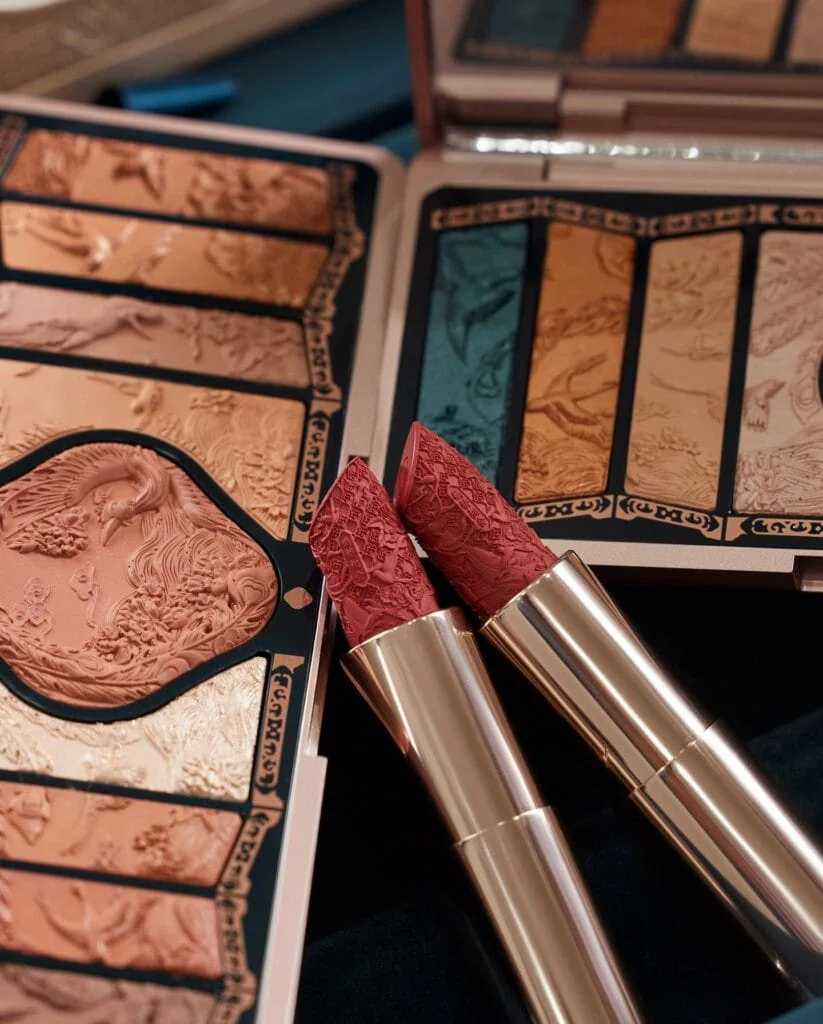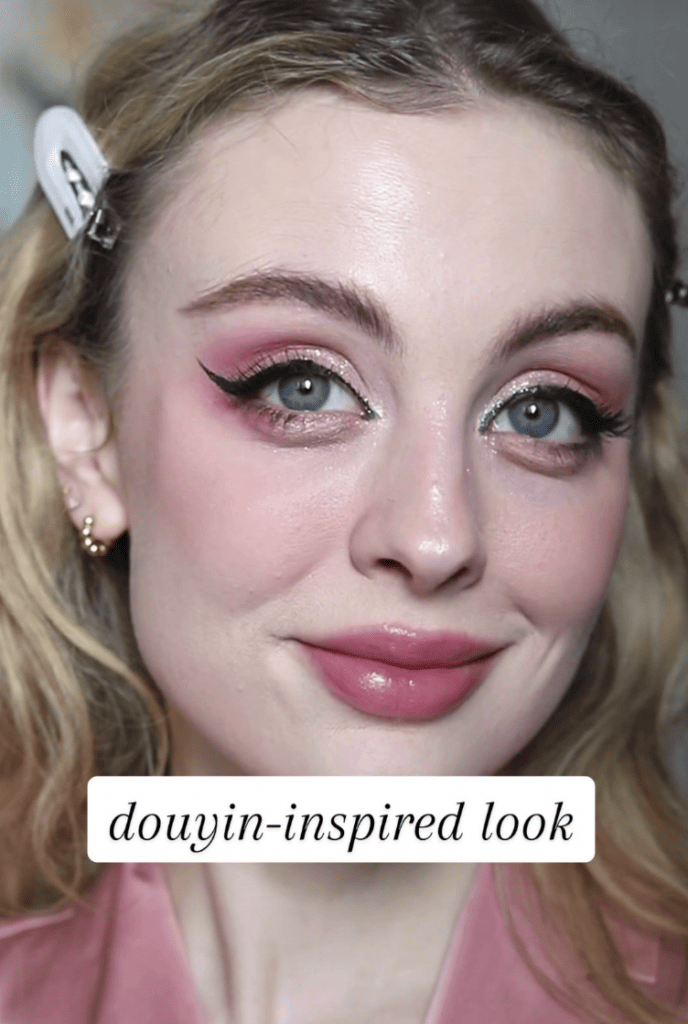A trending social media makeup style is achieving the level of international soft-power cultural influence that decades of political manoeuvring never could. As Tong Global explain in an article originally published in their latest market analysis paper, STYLE 容, ‘Douyin Makeup’ has a lot to teach us about the international expansion of Chinese beauty brands
“I’m sorry, but what is this?” – so goes the catchphrase of Mirta Miler, also known as Mimiermakeup, a top international beauty influencer who shares snappy one-minute videos showcasing various makeup trends to her 17.5 million TikTok followers. In this particular post, the 25-year-old Croatian content creator gestures in mock disbelief to a beautifully lit selfie of a young Chinese woman’s impeccably made-up face. “It’s a work of art!” she exclaims, with the overdramatic flair that has made her a celebrity of the global BeautyTok community, “I just need to try it on my face!” A series of subsequent quickly-cut clips depict the many products and steps being applied. “The Douyin makeup girlies’ skin is always super glowy,” she observes while patting her cheeks with a dewy moisturising primer from SheGlam – a cosmetics brand launched by globalised Chinese e-commerce giant Shein – to emulate the look.
This is the first C-Beauty trend to go viral overseas. C-Beauty stands for Chinese Beauty, and its growth follows a wave of interest in J-Beauty (Japanese) and K-Beauty (Korean) brands over the past 10 years or so. Sales of C-Beauty brands grew by 51% between 2017 and 2022 according to Euromonitor International, outperforming the 42% growth in the market overall. C-beauty brands accounted for 28% of retail sales among the top 20 brands sold in China last year, increasing from 14% in 2017. Popular C-Beauty brands include Florasis, Proya and Perfect Diary.
The ‘Douyin Makeup’ trend offers the world a window into China’s evolving style culture and its realm of self-expression. Derived from styles popularised by live streamers on Douyin (the domestic Chinese version of TikTok, both owned by Bytedance), this distinctive makeup look is characterised by dramatic eye contouring techniques, glittery luminescent eye-shadow, softly blurred lip colour, generous cheekbone highlighter, and doll-like clusters of long individual false lashes.
The cultural export of ‘Douyin Makeup’ on social media comes at a time when domestic Chinese cosmetics trends and brands are experiencing a market renaissance as younger users increasingly find style inspiration in their own unique experiences, heritage, local culture and media. Many are turning away from the now-outdated notion that ‘foreign is better’, a consumer phenomenon often referred to as guochao.
In the beauty space, this delves further than just skin-deep. Cult Chinese brands and products tap into the need for makeup techniques that both complement Asian features and reflect East Asian beauty standards and aspirations, such as more rounded facial structures, glassy skin, unarched brows and bright accentuated eyes.
As consumer priorities and sentiments shift, the market evolves alongside it. The cosmetics and personal care sector, now valued at £35 billion in China, used to be aggressively saturated with Western and international brands, leaving less room for domestic players to grow into, particularly at the premium level. Now, however, domestic startups are flourishing like never before. Driven to innovate and differentiate by the long-established hyper-competition of the space, and riding the wave of a new cultural climate, brands like design-conscious Judy Doll and eco-friendly LAN Time are capturing the zeitgeist.
“[In the past], I had a preference for Korean and Japanese makeup, but now my favourite is Chinese makeup. Chinese brands are doing amazing things, and I want to try every single one,” says Laura, a beauty and lifestyle KOL. “They make cosmetics that are suitable for Chinese people.”
With its glamorous feminine aesthetic, the ‘Douyin Makeup’ look draws considerable inspiration from Chinese television and stage makeup. Stars of contemporary lifestyle TV shows, as well as traditional makeup inspired by dynastical historical dramas, have formed a source of inspiration for Laura and many other makeup fans: “I was first attracted to beauty and makeup from watching TV shows as a kid. I wanted to learn how to do makeup looks just like the characters,” she says.
The specific techniques used in the ‘Douyin Makeup’ trend also reflect a merging of cultural influences, combining Chinese elements like straight ‘skinny’ eyebrows and doll eyes with the gleaming highlighter of Western contouring styles, the exaggerated glitter of music festival looks, and K-Beauty inspired ‘gradient’ lips. This is a telling example of how the guochao craze is not as simply defined as a rejection of global influences in favour of newfound nationalistic fervour.
Rather, it’s an awakening to contemporary Chinese culture and experience taking their own place of prominence alongside globalised trends and influences, driven by the young Chinese who advocate an indigenous personal style that is all their own. “When I apply makeup, I can feel what power or value this style brings to me. Makeup is about empowering self-acceptance and self-recognition,” shares Quinn, a Gen Z content creator.
Connecting to this consumer mindset has been key for high-growth C-Beauty brands that have captured the market by tapping into cultural trends, an emphasis on creative self-expression, and demand for products which are both high-performing and accessible. Case studies abound, from Colorkey’s playful yet meticulously developed lipstick colours designed specifically to enhance East Asian skin tones, to Florasis’ (花西子) artfully intricate packaging and palettes inspired by imperial Chinese antiques.

Florasis has found success in China and abroad with its Chinese antique-inspired palettes and carved lipsticks (photo captured from Instagram @florasis.official_)
“IN2U, Cai Tang, Colorkey, Flower Knows, Judy Doll; these are all Chinese brands which I love right now. A few years ago, people paid a lot of money for big established brands, but their products aren’t expensive to produce, so you are just paying for the branding,” says Laura. “These new Chinese brands have a lower price, but are also leading the trend in terms of innovation, particularly in cosmetic ingredients and textures.”
There is also a growing wave of cult interest in affordable products that deliver results comparable to high-end skincare or beauty salons. For example, La Terapia (了于) offers haircare specifically for East Asian hair using ancient Chinese hair care practices and cutting-edge biopharma technology. Similarly, TCM-inspired Herborist’s (佰草集) viral-trending Tai Chi face masks contain more than 20 active ingredients from plants.
As ‘Douyin Makeup’ and other C-Beauty influences grow their cultural stature both at home and abroad, it presents an opportunity for Western beauty brands to engage with Chinese consumers in a new light. Authentic representation, cultural fluency, and meeting audiences where they are by embracing and empowering their own trends and tastes; these tenets play a new and defining role in brand acceptance. “I appreciate brands and trends that authentically combine Eastern and Western elements,” says Quinn.
If trending styles on social media are anything to go by, then it’s clear ‘Douyin Makeup’ is only the tip of the iceberg – a paradigm shift that isn’t fading away anytime soon. Laura shares her predictions for what could be the next big crossover beauty trends: “When I go out at the weekend, I search on Xiaohongshu for trends like tianku [甜酷 ‘sweet & cool’] or yujiefeng [御姐风 ‘queen diva style’] to get inspiration.” A quick Instagram search for ‘Xiaohongshu makeup’ on Instagram also turns up a clutch of Western creators sharing and emulating unique styles found on the Chinese platform.
‘Xiaohongshu Inspired Springtime Makeup’ is the title of a series of tutorial reels by African-American beauty influencer EssenceElizabeth. In the videos, she cites products from both Western and East Asian brands, tags the Chinese KOL Jellybean_xxdd (老甜 豆儿) whose photo she references, and calls the trend – which features round face contouring, extremely subtle eyebrows and rosy red cheeks – “the prettiest makeup I have ever seen in my life!”
This article was first published in Tong’s latest market analysis paper, STYLE 容. Download the full issue here.





